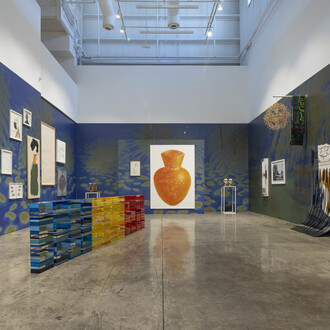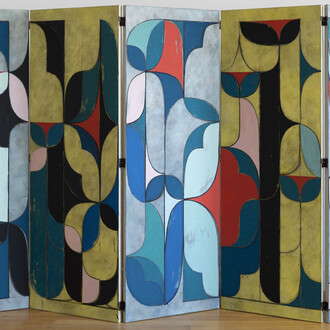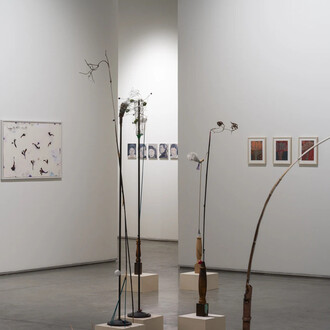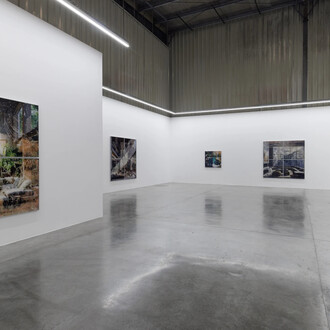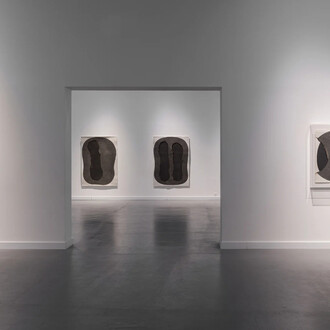Highlighting a new body of work by the seminal artist, Miniatures offers a look into Dahoul’s ongoing investigation of the principles of painting, specifically how formal elements can be used to shape the affective nature of an image. In his recent paintings, Dahoul experiments with the visual impact of scale and the challenge of shrinking monumental compositions to canvases that are the width of one’s hand. The resulting works continue his Dream series (1987-present), and treat its recurring subject matter with exacting detail despite spatial limitations. True to form, Dahoul’s miniatures carry the same psychological weight that is found in his previous works.
In a way, these new paintings are in response to the last installment of the series, which comprised large-scale works that transported the viewer when shown at Ayyam Gallery Dubai (11, Alserkal Avenue) earlier this year. Miniature paintings, conversely, demand close examination, requiring the viewer to move in closely, as though peering into a secret world. In a triptych, for example, parallel close-up portraits of his recognisable heroine show her in successive moments of stillness, as the passage of time is reflected in her eyes. One portrait shows her gaze hollowed in black, while in another she appears asleep. In a third image she stares directly at the viewer, her eyes shimmering with detail. Reminiscent of a storyboard, this triad summarises the narrative shift of the Dream series over the years as Dahoul’s female protagonist has embodied his analysis of the subconscious mind.
According to the artist, his small-scale works suggest that our dreams are diminishing in size. Symbolic meaning is further derived from allusions to the ancient art of religious painting, which can be found in both Christian iconography and Islamic art as non-representational or text-based imagery. Dahoul’s fascination with religious imagery dates back to his time in Belgium, where he encountered Flemish examples and adopted stylistic aspects of Northern Renaissance painting, particularly the melancholy and foreboding of saints.
As one of the foremost painters in the Arab world, Safwan Dahoul has repeatedly demonstrated how contemporary modes of figuration can describe the psychic terrain of a region that is in constant flux.
Born in 1961 in Hama, Syria, Dahoul was initially trained by leading modernists at the Faculty of Fine Arts, University of Damascus before travelling to Belgium, where he earned a doctorate from the Higher Institute of Plastic Arts in Mons. Upon returning to Syria, he began teaching at the Faculty of Fine Arts and was a prominent member of the Damascus art scene. In the span of a decade, Dahoul nurtured a new generation of artists as an active mentor whose evolving aesthetic often ignited new directions in painting. Given the trajectory and status of his painting style, Dahoul’s career is regarded as a crucial link between modern and contemporary Arab art.
Since the late 1980s, Dahoul’s ongoing Dream series has explored the physical and psychological effects of alienation, solitude, and longing that punctuate the human experience at various stages in life. Partly autobiographical, this seminal body of work uses the formal properties of painting to recreate the subconscious sense of enclosure that surfaces during times of crisis, whether in the event of mourning, estrangement, or political conflict. The artist’s recurring female protagonist facilitates this visceral experience through her contorted body, often-vacant eyes, and minimised yet monumental physicality. Depicted in the confinement of ambiguous settings, her presence is defined by the placement of various objects that seem to deepen the state of her disaffection, as even the familiar becomes a trigger of distress.
Dahoul’s paintings are held in numerous private and public collections, including the Institut du Monde Arabe, Paris; Barjeel Art Foundation, Sharjah; National Museum, Damascus; The Samawi Collection, Dubai; The Farjam Collection, Dubai; the Arab Fund for Economic and Social Development, Kuwait. Recently, he has participated in solo and collective exhibitions at Ayyam Gallery - 11 Alserkal Avenue, Dubai (2016); Samsung Blue Square and Busan Museum of Art, South Korea (2014); Ayyam Gallery DIFC, Dubai (2014, 2011); Ayyam Gallery Beirut (2014); Ayyam Gallery London (2013); Edge of Arabia, London (2013); and Institut du Monde Arabe, Paris (2012).










